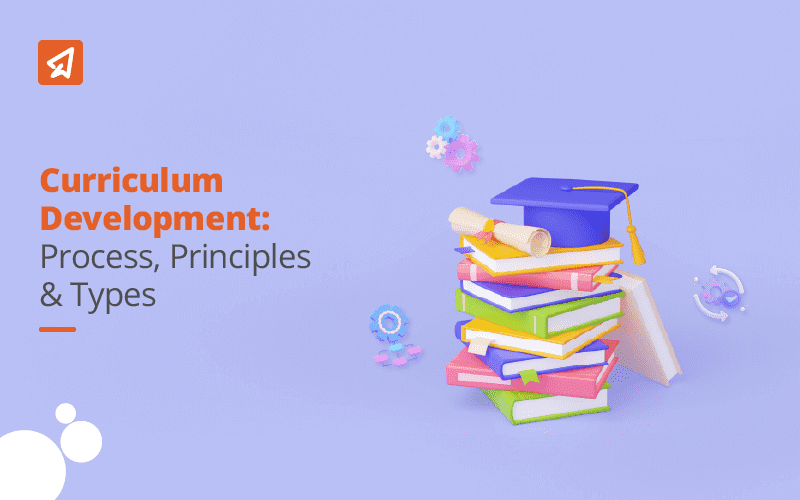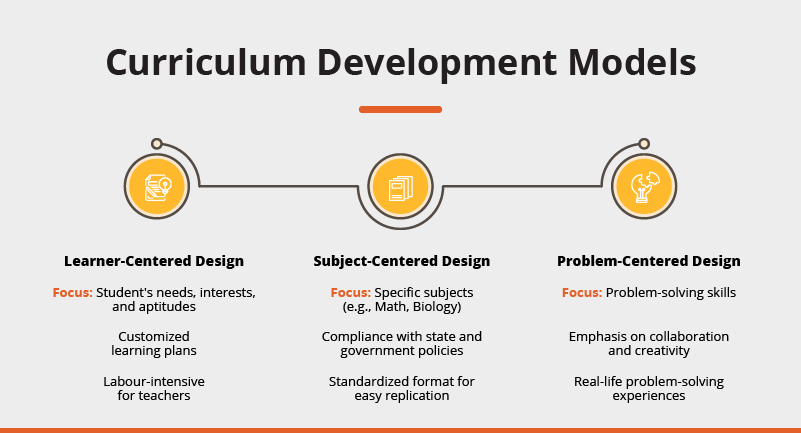Curriculum Development: Types, Principles & Process

What is Curriculum Development?
Also read: National Curriculum Framework
Elements of Curriculum Development
Curriculum strategy consists of various elements that form the basis of a robust curriculum. Once these are clearly defined, it becomes easy to draw out a holistic plan.
-
Objectives of Curriculum:
This is the core purpose of a curriculum design exercise. It asks and answers questions such as What are we trying to achieve with the curriculum and what is the goal or focus at this stage of student learning? What is the knowledge we are trying to impart and what behavioural skills are we trying to inculcate in the students?
-
Content of Curriculum:
Based on the objectives defined, this part lists the actual syllabus and topics to be covered. A curriculum developer has the tough job of balancing different factors that influence a curriculum – learning and developmental needs, cultural norms, government guidelines, school policies, etc. Overall continuity between the curriculum taught at the previous level and the one to be taught at the next level also needs to be taken into account.
-
Teaching/ Learning Methodologies:
This part lays down how the curriculum will be rolled out. It deals specifically with instruction design. Which lessons will benefit more from interactive teaching styles and which from the traditional instruction methods? The objective is to arrive at the most effective teaching methods or strategies for the given behavioural, cognitive, and applicable knowledge to be imparted. This section also deals with the methods most suitable for the assessment of this knowledge.
-
Evaluation of Curriculum:
Different from student learning assessment, the focus here is to evaluate if the designed curriculum meets the initial objectives laid out for it and achieves the desired results.

Types of Curriculum Development Models

-
Learner-centred Design
Focused on the student this model focuses on the needs, interests, and requirements of the student. Every student has different learning needs and aptitudes. The design and plans under this approach are differentiated keeping this in mind, while adhering to a broad outline basis an overall understanding. Though the most inclusive and sensitive to differing needs, this approach can be very labour-intensive for teachers.
-
Subject-centred Design
Under this model, the focus is on a specific subject or discipline like Math or Biology. It stresses certain core subjects and is driven by state and government policy on education. Though the curriculum is developed keeping in mind the cognitive abilities of students at a particular age, the focus is more on the subject matter than the student. Because it is a standardised format, it is easier to replicate across schools with set material and teacher training.
-
Problem-centred Design
More student-centric than subject-focused, this model rests on equipping students with problem-solving skills. It works to teach them different ways of approaching a problem, communication skills, and the importance of collaboration. Students learn by working on real-life problems, bringing in their creativity and innovative ideas.
A balanced curriculum needs to integrate all three models to arrive at a more inclusive yet readily replicable approach.
Steps of Curriculum Development
-
Identify the Needs
The first step in the curriculum development process is to understand the target audience and what their needs are. Though educators might be familiar with the standard developmental needs of students, swiftly changing environments generate newer learning requirements for them. Be it making the information more current, changing technology, or sudden changes in the learning environment with the pandemic, each of these developments warrants a change in the curriculum design. Being the ones implementing the curriculum, educators also receive first-hand insights and feedback on its merits and challenges. This puts them in a unique position of being able to identify any gaps in the curriculum, aligning with the ethos of the National Education Policy (NEP) which emphasizes the need for dynamic and responsive curriculum frameworks.
45% principals prefer Extramarks for NEP-ready solutions
-
Build a Curriculum Development Team
Building a curriculum is a team job. It needs the input and collaboration of Educators, Education policy experts, Content creators and designers, Government and school officials as well as Publishers of textbooks. This team needs a manager who can discuss and assign roles, list deliverables, set timelines, and most importantly keep everyone aligned and working toward the common goal of curriculum development in education.
-
Assess and Analyse the Requirements/ Needs
This step is different from the first one in that, that the first step identifies the gaps in the curriculum and the needs of the students. This step is more curriculum-oriented. It works to identify the information and expertise required in the curriculum development process. It assesses what aspects of the curriculum design need reworking – product (new knonwledge), process (a different teaching method), or expertise (teacher training).
Also Read: NEP 2020 Exams and Assessment Reforms
-
List the Intended Outcomes
Equipped with the information from steps 1 & 3, here, the team refines and re-articulates the goal and puts down the intended outcome. This detailed documentation puts down what new knowledge the student is getting, how it is imparted, and the resultant learning that takes place. It also covers the process, conditions, and outcomes at each stage of curriculum development.
-
Shortlist and Select Content
The previous step feeds into this one. With a detailed road map of the desired outcome, the team now gets down to shortlisting and selecting the content. Factors such as current knowledge, skills, cultural implications, influence, and impact on the students play a key role in deciding this content. The detailing and depth of the topic as well as the sequence of information to be taught is also defined here.
-
Develop Teaching Methods
Once the team has finalised the ‘What’ in the curriculum design, they next work on the ‘How’. At this stage, different teaching methods and strategies are evaluated to shortlist the most efficient one to drive the change in the curriculum and lead to the intended learning behaviours. Technology plays a big role today in engaging students and driving classroom learning. It has become one of the most resourceful allies for teachers not just in concept detailing but also in designing assessments. Smart Edtech providers such as Extramarks Assessment Center help teachers create effective assessments at each stage for better learning.
-
Finalise, Test, and Revise the Curriculum
After all the hard work, it is time to take one final look at the changes introduced in the curriculum. This step is all about running the new curriculum through some test sites and getting feedback from other stakeholders. It makes sure that the changes align with the goals set at the beginning of this exercise before rolling it out. Some minor tweaks and realignment can make all the difference between a welcome change and a failed exercise.
Principles of Curriculum Development
The principles of curriculum development are broad guidelines that ensure a holistic outcome for teachers, students and the education sector in totality. These principles outline the values that are the foundation for good curriculum and instructional design. Principles of curriculum planning include:
-
Principle of Totality of Experiences
A curriculum is not just concerned with academic subjects or topics being taught but also must include the total learning experience a student receives at a school or college. A curriculum is responsible for the all-round development of a child through the totality of experiences gained such as extra-curricular, co-curricular, and sporting activities.
-
Principle of Child-Centeredness
A curriculum’s first responsibility is toward the learner. If it fails to engage and interest a student it fails its purpose. It needs to go beyond the bookish knowledge and work with the developmental needs of the student. Only when the child is kept at the centre of a curriculum design can it be structured to serve their interests.
-
Principle of Conservation and Creativity
A curriculum needs to be both fixed and dynamic at the same time. It should provide knowledge of cultural heritage, history, and cultural identity to students at the same time be malleable enough to include changing global trends without becoming static and irrelevant.
-
Principle of Integration
The curriculum needs to be sensitively designed such that it doesn’t alienate any segment of society. Students should be able to relate to it and more specifically be able to correlate one subject with another.
-
Principle of Flexibility
A curriculum needs to be adaptable. It needs to be open to updations and additions depending on changing knowledge, trends, and learning requirements.
-
Principle of Utility
The curriculum should pass through the litmus test of utility. A curriculum should be useful for the cognitive, behavioural, and foundational development of a child. Not only that, it needs to impart useful skills that a student might need as an adult.
-
Principle of Character Formation
The role of curriculum and educators is much larger than the transfer of knowledge, concepts, and understanding of subjects. It is also to prepare the future of the human race. To build the character and value system of people who will be adults tomorrow and the ones leading the charge.
-
Principle of Mental Discipline
One of the key roles of a curriculum is to help students develop the discipline and handwork required for learning. It also plays a role in building the importance of practice in sharpening mental faculties.
-
Principle of Social Fulfilment
And lastly, the curriculum also holds considerable weight in developing social responsibility among the students towards the planet and society at large. It should work towards helping students excel in life beyond the classroom.
Factors Influencing Curriculum Development
Principles discussed in the previous section were broad guidelines universally applicable to all curriculum designs, influencing factors, on the other hand, are region-specific and can vary across demographics, schools, cities, and states.
-
Psychological Factors
How students perceive and react to the curriculum being taught, how they engage with the instruction design, how their nature and personalities align with those of the educator, teaching strategy and the subject can have a significant impact on the learning process.
-
Political Factors
Governments are active stakeholders in the education policy of any country. They have to keep an eye on the curriculum aligning with the national interest, a sense of patriotism, and national history.
-
Philosophical Factors
The outlook of members of the curriculum team needs to be in alignment with each other. A cohesive and definite direction for clear execution far outweighs the drawbacks of being pulled in different directions leading to ineffective results.
-
Gender Factors
Both the class demographic and the educator’s gender can sometimes aid or hinder the progress of the curriculum. Especially in rural areas, gender is seen to be skewed in the senior classes.
-
Societal Factors
Societal factors play a huge role in influencing the curriculum and vice versa. A curriculum consciously and sensitively designed can begin to change certain mindsets in society. On the other hand, understanding society and the background around the school, its teachers, and students can go a long way toward building awareness, tolerance, and flexibility for the curriculum and teaching methods.
-
Technological Factors
The extent of technology used in the teaching methods depends on the school’s policy. However, a curriculum should be built with options of using technology or going without it. This gives the schools flexibility to decide the extent of technology they want to introduce depending on the trends, access, and comfort of the teachers as well as students.
-
Economical Factors
The socio-economic background of the schools, its teachers, and students play a pivotal role in executing the curriculum. A curriculum needs to work for both elite, top-layered schools and at the same time for the ones with a basic set-up.
-
Educational Factors
The success or failure of a curriculum rests on its execution. Training programs should be planned for both Educators and students. Only when the educators are aligned to the curriculum can they impart it efficiently.
Tips and Strategies for Curriculum Developers
To sum up, here are a few quick pointers
- Create a curriculum map: Use flow charts, diagrams, and visuals. Add milestones as a quick snapshot of the curriculum design. It saves time when a quick reminder is needed and provides a ready reckoner to keep everyone on track.
- Put the needs up in bold: Use the needs of the target audience identified earlier as the filter whenever you hit a roadblock or reach an inconclusive debate amongst the team.
- Keep the focus on the students: If it doesn’t serve them, it doesn’t serve the purpose.
- Don’t be in a rush: Designing a good curriculum takes time. You can’t do it in a hurry. Set clear timelines, and goals at the start, then track meticulously to avoid last-minute stress.
- Get in the experts: Designing a curriculum is a team job. You will need all the experts to weigh in.
- Evaluate: Be sure to evaluate and take in feedback before you roll out the curriculum.
- Be flexible: Be open to making changes. It is better to course correct instead of reaching the wrong destination.
- Use technology: Technology is your friend. Extramarks is your perfect partner to help you develop and execute your curriculum with the aid of technology.
Curriculum design is the foundation through which educators can build a collective future. Armed with deep knowledge and core values, nurtured in the right environment learners of today will lead the world of tomorrow.
Upgrade how you deliver the curriculum designed and maximise student learning and outcomes with Extramarks School Solutions.
Learn MoreLast Updated on February 18, 2025
Reviewed by

Prachi Singh | VP - Academics
Prachi Singh is a highly accomplished educationist with over 16 years of experience in the EdTech industry. Currently, she plays a pivotal role at Extramarks, leading content strategy and curriculum development initiatives that shape the future of education...read more.











